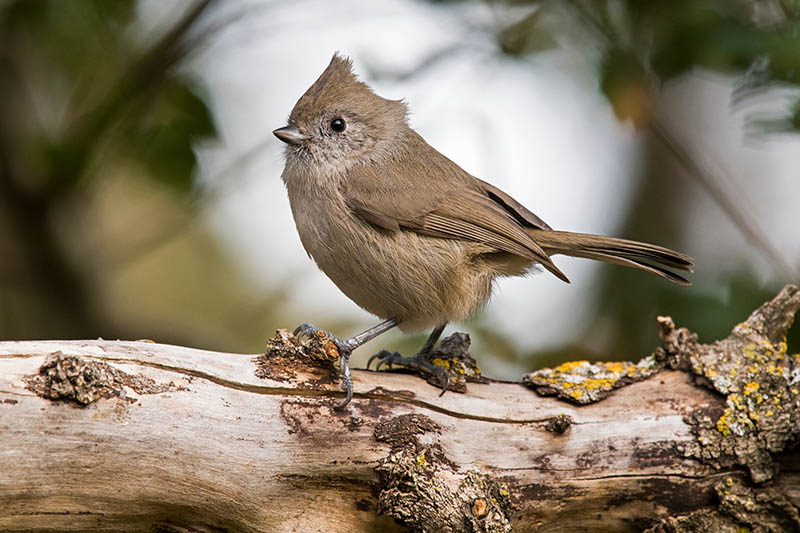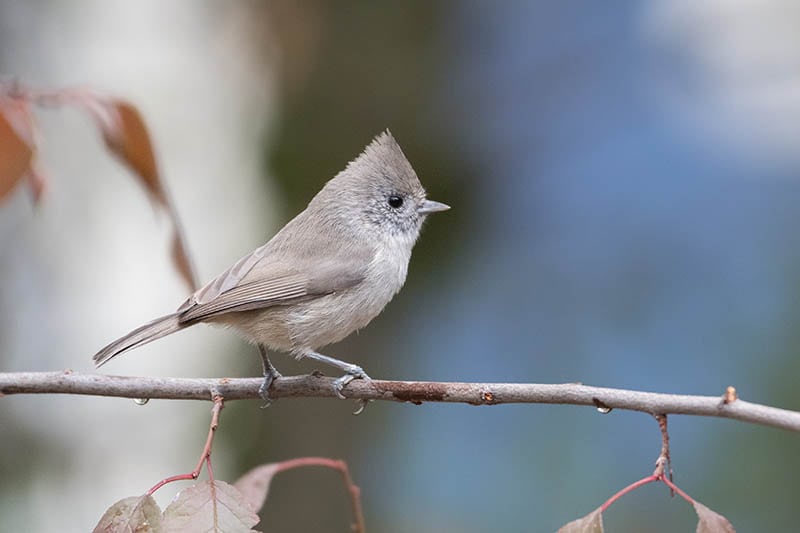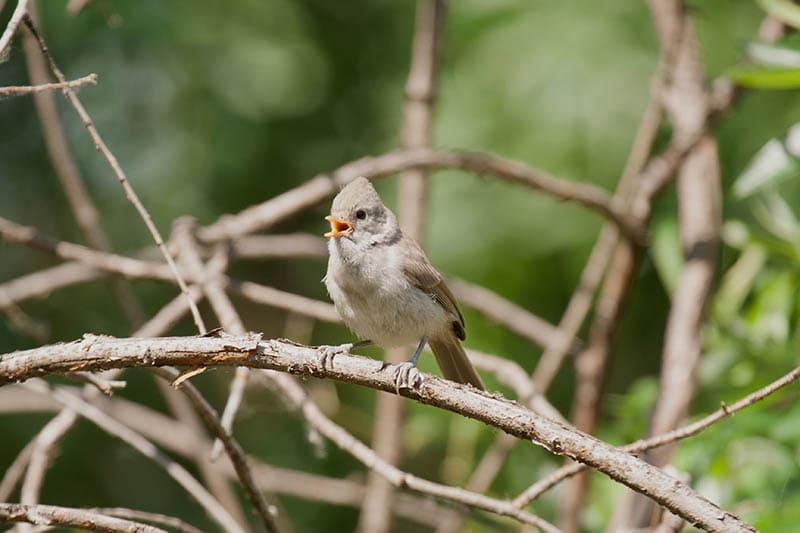Oak Titmouse: Field Guide, Pictures, Habitat & Info
Last Updated on

The Oak Titmouse is a small brown songbird with a slightly pale belly and black eyes. These active birds dine on seeds and insects and have a distinctive rapid song. They get their name from the fact that they typically live in the tops of oak trees, although they may be found in pine forests. They’re found primarily in California with small numbers also located in Oregon and Baja. They can be found at feeders and are usually attracted by seeds and suet, and these non-migratory birds can be seen all year round.

Quick Facts About the Oak Titmouse

| Habitat: | Oak trees, occasionally pine trees |
| Diet: | Insects, seeds, acorns, fruit |
| Behavior: | Very active, can be protective over nests |
| Nesting: | Nest in tree cavities or nesting boxes |
| Conservation: | Least concern |
| Scientific name: | Baeolophus inornatus |
| Lifespan: | 8 years |
Oak Titmouse General Description
The Oak Titmouse is a small songbird that lives predominantly in California, although small numbers may be found in Oregon. The bird is small, is a gray-brown color, and prefers oak trees as its natural habitat. It has a sharp, repetitive call, which can be heard in the treetops of its habitat, and the species can be attracted to feeders and nesting boxes throughout the year because they are non-migratory birds.
Oak Titmouse Range, Habitat, Behavior, Diet & Nesting
The Oak Titmouse was first recognized by the American Ornithologists’ Union in 1996 when the common titmouse species was split into the Juniper Titmouse and Oak Titmouse. The differentiation was made because the two groups not only have different genetic makeup but different preferences in habitat.
Range
The Oak Titmouse has a fairly restricted range, predominantly being found in California where it lives on dry slopes. However, a small number of the birds may also be found in Oregon and some in Baja California.
Habitat
The Oak Titmouse is named for its preference for oak trees. As such, it will usually be found nesting and foraging in these trees. Some do live in pine forests and forests that contain both oak and pine trees. The species is non-migratory, which means it can be found throughout the year.
Behavior
An active bird, the Oak Titmouse can seem skittish as it hops from branch to branch looking for insects and gathering seeds, fruit, berries, and other foods. It has a high-pitch, rapid song, which can be heard from among the tops of oak trees throughout the year.
Diet

As well as feeding on insects found on trees, the Oak Titmouse will catch insects in flight. They will also feed on seeds, as well as acorns and some berries and fruit. Although they will usually forage on branches and high up in trees, they can sometimes be seen gathering food on the ground.
Nesting
This songbird will live in natural cavities in oak trees and pine trees. They may also live in abandoned woodpecker nests and can also be found in holes in fences and other manmade structures. Oak Titmice can also be attracted to nesting boxes. Male and female will work to further hollow out an existing cavity if it is not large enough, and it is the female that selects a nesting site. It can take around a week for the female to finish readying the nest which will be filled with hair, feathers, bark, wool, twigs, fibers, and other organic materials.
How to Find Oak Titmice: Birdwatching Tips
The small size of the Oak Titmouse and its propensity to nest high above the ground means it can be difficult to spot this pretty little songbird. However, they do have a recognizable call and they can be attracted to backyard feeders, which increases the odds of you spotting them.
What to Listen For
Although they have a collection of sounds, all Oak Titmice songs have a sharp upper note and some lower notes. The song has a steady tempo and has been described as scratchy.
What to Look For
Although the songbird is small and has a non-descript, gray-brown color, it has a distinctive crest on the top of its head which can be raised or lowered. It also has black eyes.
When to Look
The species is active throughout the year and is a non-migratory songbird. Therefore, it is possible to see it any time of the year. It is active throughout the day. Breeding season is between March and July, so these are the times when you are most likely to see pairs together.
Attracting Oak Titmice to Your Backyard: Tips & Tricks
Oak Titmice can be attracted to nesting boxes and to feeders. They will scavenge seeds and usually eat them away from the feeder.
Put nesting boxes up before March, which is when breeding season starts. Add some kind of guard to prevent predators from getting in and having away with the eggs and try to provide foliage in the area, so that the female can easily gather the supplies she needs to be able to build her nest.
For feeders, Oak Titmice like suet and seeds. Put up a suet ball or suet hanger and add sunflower seeds to your feeders. Try to site the feeder near trees so that the birds have somewhere to retreat to and use platforms or tubes.

Oak Titmouse Conservation: Is this Bird Threatened?
The species is considered to be of least concern to conservationists and is one of the most prevalent songbirds in California. However, its numbers have been declining since 1966. Since that time, its numbers have fallen to around half a million breeding population in the US and Mexico.

Final Thoughts
The Oak Titmouse can appear quite plain and uninteresting at first glance thanks to its gray-brown coloring. However, its crest does offer some visual appeal, and it is said to have a similar “peter-peter-peter” song to that of the Tufted Titmouse. The bird is non-migratory, usually found in oak trees but occasionally in pine trees, and can be attracted to feeders and nesting boxes in the garden.
Featured Image Credit: Laurie E Wilson, Shutterstock
About the Author Robert Sparks
Robert’s obsession with all things optical started early in life, when his optician father would bring home prototypes for Robert to play with. Nowadays, Robert is dedicated to helping others find the right optics for their needs. His hobbies include astronomy, astrophysics, and model building. Originally from Newark, NJ, he resides in Santa Fe, New Mexico, where the nighttime skies are filled with glittering stars.
Related Articles:
10 Types of Hummingbirds in Arkansas (With Pictures)
8 Types of Hummingbirds in Nebraska (With Pictures)
5 Types of Hummingbirds in Idaho (With Pictures)
3 Types of Hummingbirds in Mississippi (With Pictures)
8 Types of Hummingbirds in Kansas (With Pictures)
5 Types of Hummingbirds in West Virginia (With Pictures)
5 Types of Hummingbirds in Ohio (With Pictures)
Where Do Nuthatches Nest? Nuthatch Nesting Habits Explained
